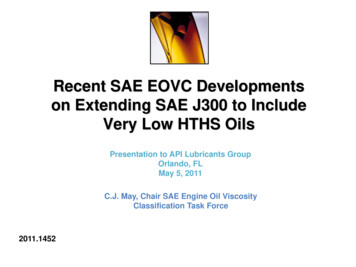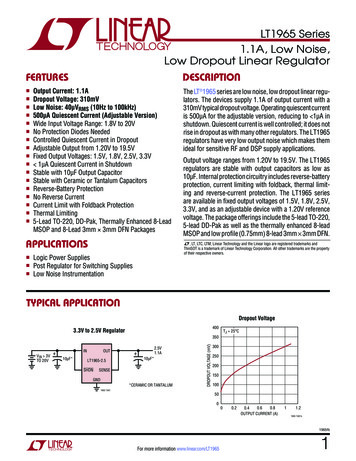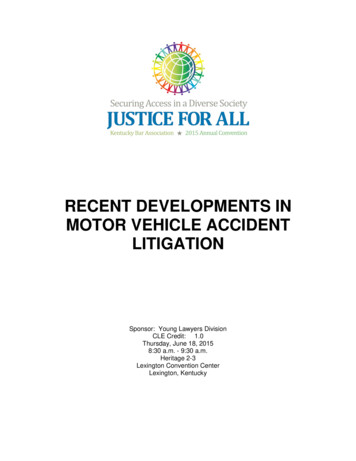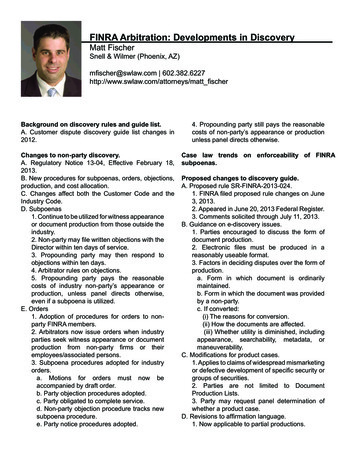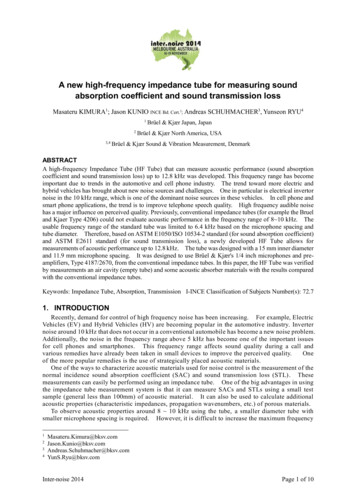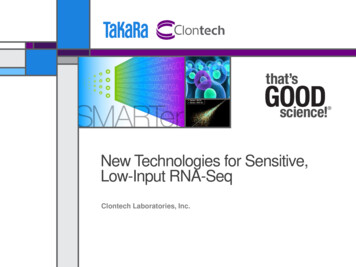Transcription
New Developments in MeasuringLow Silicon in Process PipingUsing Handheld X-rayFluorescence (XRF)Presented by: Mark LessardBusiness Development ManagerThermo Fisher Scientificmark.lessard@Thermofisher.com
Outline Introduction- Corrosion Failures in Oil and Gas Sulfidation / Sulfidic Corrosion Elemental Analysis and Positive Material Identification(PMI) Principals of XRF Advances in handheld XRF PMI tools for Sample Preparation Interactive Demonstration of XRF Questions and Answers
Corrosion Failures in Process Piping 41% of the largest losses in the hydrocarbon processing industry resulted fromfailures in piping systems Corrosion is one of the leading causes of piping failures OSHA’s National Emphasis Program (NEP) includes positive materialidentification (PMI) “Recognized And Generally Accepted Engineering Practices” or “RAGAGEP”– Example RAGAGEP for PMI: API RP 578, Material Verification Program for New and Existing AlloyPiping Systems, Section 4.3 CSB, Safety Bulletin – Positive Material Verification: Prevent ErrorsDuring Alloy Steel Systems Maintenance, BP Texas City, TX Refinery Fire Second International Symposium on the Mechanical Integrity of Process PipingJanuary 1996, Houston, TX, USA
Sulfidation/Sulfidic Corrosion Two mechanisms:– Hydrogen-free sulfidation– H2/H2S Corrosion Result of naturally occurring sulfur compounds foundin crude oil Causes accelerated corrosion in steel fittings, piping,heater tubes, and pressure vessels when the oil isheated for separation A significant cause of leaks and failures of pipingsystems within the refining industry
Sulfidation/Sulfidic CorrosionThe rate of sulfidation corrosion is a function of many factorsincluding Temperature Total sulfur concentration in the oil Types of sulfur compounds present Type of stream (light gas or heavy oil) Velocity Heat transfer conditions The presence or absence of hydrogen The material of construction
Using Elemental Analysis to PreventSulfidation CorrosionHydrogen Free Sulfidation Increasing chromium content has a substantial effect oflowering the rate of sulfidation When carbon steel components are exposed to hydrogen-freesulfidation, those components with low Si content ( 0.10%)may corrode at a significantly higher rate ( API 939-C )H2/H2S Corrosion Carbon and low-alloy steels are ineffective in combatingsulfidation below alloying levels of 12Cr-1Mo It is most common to use 18Cr-8Ni (300-series stainless) orhigher alloyed steels in these environments
In-Situ Elemental Analysis of PipingSystems2 Primary Technologies for Portable Analysis:Optical Emission Spectroscopy (OES) Technique of vaporizing sample surface and analyzing theemitted light spectra. The wavelength of the light correspondsto the elements present, while the intensity is a function ofquantity of that element.X-ray Fluorescence Spectroscopy (XRF) Technique of exciting and ejecting atoms’ inner shell electronswith x-ray radiation and analyzing the fluorescent x-rays emittedwhen the atoms return to a stable state. X-ray energies emittedcorrespond to the individual elements, while the intensity is afunction of quantity.
Pros:Handheld XRF Spectroscopy Accurate Portable - The handheld XRF analyzer weighsapproximately 1.3 kg (3 lbs.) and is transported in abelt holster at the user’s side Reduced sample preparation Completely nondestructive Simplicity - XRF technology is user-friendly, allowingrelatively unskilled operators to participate in theinspection processCons: Can measure elements only down to Mg on theperiodic table (cannot do carbon) Stricter regulation and licensing requirements
How XRF Works Each individual elementproduces its own set ofcharacteristic x-rays; thebasis for qualitative analysis By counting the number ofcharacteristic x-rays of agiven element we candetermine itsconcentration; the basis forquantitative analysis
XRF Evolution in Performance Since late 1960s, XRF has evolved through 7 generations; each generation has addednew measurement capabilities as indicated by the (3) groups below– Smaller, Faster, Better performance & Easier to useToday, nearly all alloys can be tested with these powerful tools. This addresses PMIConcerns in the Upstream /Downstream & Transportation MarketsMeasured (1) Element at atime to: 1.00% Chemistry in / 1 to 2 minutesMeasured ( 16 to18 )Elements at a time to: 0.01% Chemistry in / 30 to 60 secondsMeasures ( 25 to 30 )Elements at a time to: / 0.003% Chemistry / 3 to 12 seconds
New Ultra Detector TechnologyThe Specs 25mm2 to 45mm2 Silicon Drift Detector (SDD) Greater surface area allows for maximization of tube current and greater overalllight element X-Ray flux. Optimized voltage- By reducing voltage (with larger detector) it allows forexcitation of Si without measuring Fe for improved Limits of Detection ( LOD ) Thinner window to maximize Mg-Si detection of returning fluorescence X-Rayenergy Higher count rate of crucial light elements ( 400K counts per second )The Results Next evolution in light element analysis in air (Mg, Al, Si, P, S)Detection limit for Silicon approximately 350 ppm in air.Increased sensitivity for tramp & trace elements in all alloysEven FASTER analysis of alloy and metals testingNew TechnologyOld Technology
Auto Filters for Different Groups ofElements
Elements of Interest: Limits ofDetection (LOD)Detection LimitsSiMnNiCuCrMo210160100703515Limits of detection for advanced handheld XRF analyzers in ppm (mg/kg)SDD detector, 60 seconds per filter without He purgeMain Filter isfor: All ElementsLow Filter for:Cr, V, TiLight Filter is For:S, P, Si, Al, Mg
Existing Piping Systems ( Retro-Active PMI ) ProgramsPriority for API RP 578 2nd Edition – “High Temperature Sulfidic Corrosion - API RP 939-C”Process Units Susceptible to Sulfidation: Carbon Steels with low silicon (0.10%) content can corrode at an accelerated rate Assets at risk from this type of degradation should apply PMI control to determineSilicon levels. (Retro-Active PMI is suggested and to follow API 578.) See API 571 and API RP 939-C See Section 7.1.4 & 5SamplePreparationis RequiredLow Si-33%,PMI-18%,Specification Break-17%
Corrosion Rate of Low-Si Carbon Steel
Measuring Low Silicon in the Field Current Technologies both ( XRF/OES) have limits for the Process Temperature Range.Proper Sample preparation is required.Most material of concern for Sulfidation is Carbon Steel piping installed before 1985.This material was usually double/tripled stamped ( A53/A106/API 5LB,& A285 Plates ).Typically, fittings have higher Si content, whereas piping straight runs have less Si.Specification breaks are also a contributing factor ( 5Cr welded to 9Cr ).Other Concerns for high temperature process ( 650 F and greater ) is using 5 Cr and 9Crwith both low Cr & Si.
Sample Preparation for Low SiTypical metal alloys used in the petrochemical industry will oxidize when exposed toatmospheric conditions. This oxide coating can affect the accuracy of the reading whenperforming an XRF analysis and must be removed.Sample contamination can occur if you prepare with the wrong abrasive disc. It isrecommended to use grinding discs made from zirconium aluminum oxide. Zirconium is ametal not commonly found in steel alloys, so trace amounts found on the surface will notnegatively affect test results.As a recommended starting point, the following grit sizes are suggested: Stainless Steel – 120 gritCr/Mo Steel – 80 gritCarbon & Low Alloy Steel – 60 grit.Rubber backing wheelAbrasive discsHandheld, right angle grinder
Priority for API RP 578 2. nd. Edition – “High Temperature Sulfidic Corrosion - API RP 939-C” Process Units Susceptible to Sulfidation: Carbon Steels with low silicon (0.10%) content can corrode at an accelerated rate Assets at risk from this type of degradation should apply PMI control to determine Silicon levels. (Retro-Active PMI is suggested and to follow API 578.) See .
